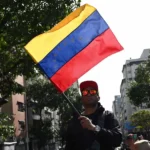
The destruction of the forest, combined with reduced rainfall, intensifies the impacts of climate change.
The Brazilian Amazon, home to two-thirds of the world’s largest rainforest, saw its highest number of fires in 14 years during August, according to Brazil’s National Institute for Space Research (INPE). Other biomes affected include the Cerrado, a vast tropical savannah in the center of the country, and the Pantanal, in the south.
This year, the total area burned in Brazil was estimated at 34.5 million hectares — equivalent to the size of Germany — more than double the average recorded between 2012 and 2023, according to the Global Wildfire Information System (GWIS). The system, which uses satellite data to assess burned areas, is a joint initiative by Copernicus and NASA.
High temperatures, which exceeded 40°C in some regions, combined with prolonged drought, have turned delicate ecosystems into veritable “tinderboxes”. Authorities point out that in many cases, human action was the initial spark, highlighting “slash and burn” practices used by farmers and ranchers, as well as criminal activities aimed at deforesting forest lands.
Although small-scale fires are part of the natural ecological cycle in the Cerrado and Pantanal, the severity of this year’s fire season has raised serious concerns. The government of President Luiz Inácio Lula da Silva, which has prioritized environmental protection, is mobilizing additional resources for the most affected regions.
Despite the decline in deforestation in the Amazon under Lula’s administration, decades of destruction continue to contribute to drought and fires, according to geologist and climatologist Pedro Cortes of the University of São Paulo. He explains that the reduction in humidity generated by the Amazon, known for its “flying rivers” — clouds that transport water vapor to other parts of South America — is directly linked to the decrease in rainfall.
Scientists also point out that global warming is playing a central role in intensifying the weather phenomena affecting Brazil. “The evidence is clear: climate change is worsening these crises,” said Izabella Teixeira, Brazil’s former environment minister. She added that Brazil could face more frequent extreme weather events as global warming intensifies.
Smoke from the fires has spread across parts of South America, including countries such as Peru and Bolivia. In Bolivia, the government has declared a national emergency, facing the highest number of forest fires since 2010, according to INPE. In La Paz, the Bolivian capital, many schools have closed and classes have been moved online.
The drought in Brazil, described by the National Center for Monitoring and Alerts for Natural Disasters (Cemaden) as the “most intense and widespread” in the country’s history, began in mid-2023. The government agency estimates that almost 60% of Brazilian territory is being affected in some way.
Ana Paula Cunha, a researcher at Cemaden, points out that the El Niño phenomenon, which warms the Pacific Ocean, was one of the factors that worsened the situation last year. This year, the overheated North Atlantic has also contributed significantly. Cunha says that although rain may soon ease the south-central part of Brazil, the forecast is for below-average precipitation in states that are already facing a critical situation.
The impacts of the drought are also affecting major waterways in the Amazon basin, which have reached historic lows, making it difficult to supply water to remote communities dependent on river transport. Crops such as coffee and oranges have also been affected in several regions. Low reservoir levels have led regulators to increase energy tariffs, as Brazil’s energy matrix is predominantly hydroelectric.
The wildfires have also caused public health problems, with the spread of dangerous micro-particulate matter covering both rural areas and urban centers. On Thursday, the smoke column covered about 33% of Brazil’s territory, and about 11% of the country was exposed to dense smoke, according to calculations by the Financial Times based on data from the Copernicus Atmosphere Monitoring Service.
São Paulo, Brazil’s largest city, this week recorded the worst air quality among 120 major cities worldwide, according to the Swiss platform IQAir. Last month, the western Amazon region was the most polluted area in the world due to forest fires. “Emissions have reached historic levels from August until now, with volumes well above average,” said Mark Parrington, a senior scientist at Copernicus. He added that areas such as Bolivia, Amazonas and Mato Grosso do Sul are recording annual emissions from fires close to or above the highest levels in the past 22 years.
South American fires in 2023 will emit 72% more carbon dioxide than the 2012-2023 average, according to GWIS. “This scenario will further accelerate climate change,” warned Marcio Astrini, executive secretary of the nonprofit Climate Observatory. “We need more aggressive action. This is the time to increase penalties for environmental crimes in Brazil, especially those related to fires and deforestation.”
Via Financial Times
Source: https://www.ocafezinho.com/2024/09/14/incendios-no-brasil-disparam-area-queimada-ja-e-maior-que-a-alemanha/

